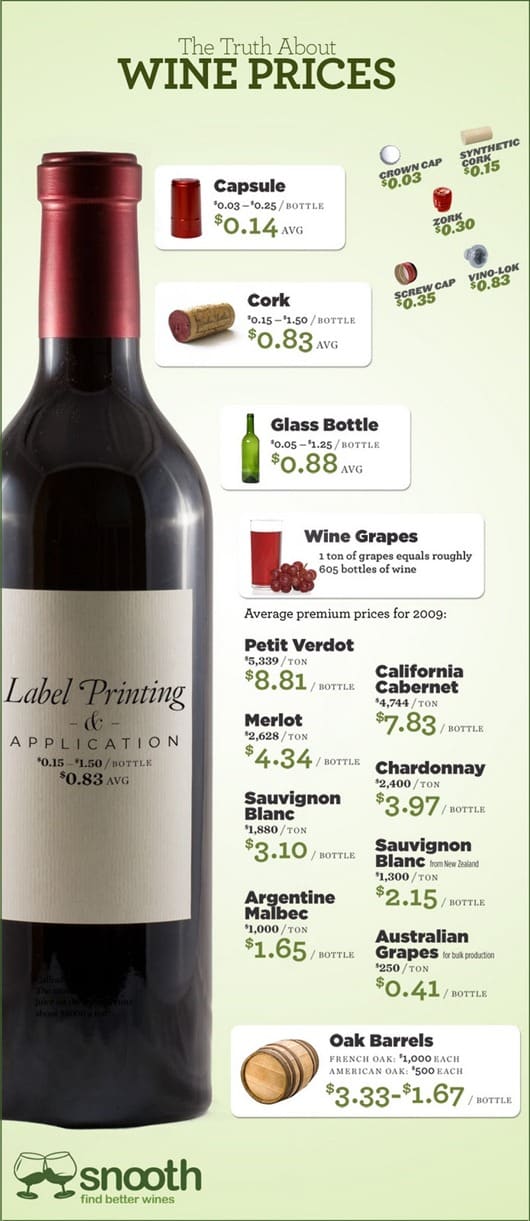I’m sure there’ll be a little agreement over some of these numbers, but I think it provides quite a cool little basic visualization of what goes into/onto a bottle.
I’m sure there’ll be a little agreement over some of these numbers, but I think it provides quite a cool little basic visualization of what goes into/onto a bottle.
Blog Your Wine
We firmly believe that the internet should be available and accessible to anyone, and are committed to providing a website that is accessible to the widest possible audience, regardless of circumstance and ability.
To fulfill this, we aim to adhere as strictly as possible to the World Wide Web Consortium’s (W3C) Web Content Accessibility Guidelines 2.1 (WCAG 2.1) at the AA level. These guidelines explain how to make web content accessible to people with a wide array of disabilities. Complying with those guidelines helps us ensure that the website is accessible to all people: blind people, people with motor impairments, visual impairment, cognitive disabilities, and more.
This website utilizes various technologies that are meant to make it as accessible as possible at all times. We utilize an accessibility interface that allows persons with specific disabilities to adjust the website’s UI (user interface) and design it to their personal needs.
Additionally, the website utilizes an AI-based application that runs in the background and optimizes its accessibility level constantly. This application remediates the website’s HTML, adapts Its functionality and behavior for screen-readers used by the blind users, and for keyboard functions used by individuals with motor impairments.
If you’ve found a malfunction or have ideas for improvement, we’ll be happy to hear from you. You can reach out to the website’s operators by using the following email
Our website implements the ARIA attributes (Accessible Rich Internet Applications) technique, alongside various different behavioral changes, to ensure blind users visiting with screen-readers are able to read, comprehend, and enjoy the website’s functions. As soon as a user with a screen-reader enters your site, they immediately receive a prompt to enter the Screen-Reader Profile so they can browse and operate your site effectively. Here’s how our website covers some of the most important screen-reader requirements, alongside console screenshots of code examples:
Screen-reader optimization: we run a background process that learns the website’s components from top to bottom, to ensure ongoing compliance even when updating the website. In this process, we provide screen-readers with meaningful data using the ARIA set of attributes. For example, we provide accurate form labels; descriptions for actionable icons (social media icons, search icons, cart icons, etc.); validation guidance for form inputs; element roles such as buttons, menus, modal dialogues (popups), and others. Additionally, the background process scans all of the website’s images and provides an accurate and meaningful image-object-recognition-based description as an ALT (alternate text) tag for images that are not described. It will also extract texts that are embedded within the image, using an OCR (optical character recognition) technology. To turn on screen-reader adjustments at any time, users need only to press the Alt+1 keyboard combination. Screen-reader users also get automatic announcements to turn the Screen-reader mode on as soon as they enter the website.
These adjustments are compatible with all popular screen readers, including JAWS and NVDA.
Keyboard navigation optimization: The background process also adjusts the website’s HTML, and adds various behaviors using JavaScript code to make the website operable by the keyboard. This includes the ability to navigate the website using the Tab and Shift+Tab keys, operate dropdowns with the arrow keys, close them with Esc, trigger buttons and links using the Enter key, navigate between radio and checkbox elements using the arrow keys, and fill them in with the Spacebar or Enter key.Additionally, keyboard users will find quick-navigation and content-skip menus, available at any time by clicking Alt+1, or as the first elements of the site while navigating with the keyboard. The background process also handles triggered popups by moving the keyboard focus towards them as soon as they appear, and not allow the focus drift outside of it.
Users can also use shortcuts such as “M” (menus), “H” (headings), “F” (forms), “B” (buttons), and “G” (graphics) to jump to specific elements.
We aim to support the widest array of browsers and assistive technologies as possible, so our users can choose the best fitting tools for them, with as few limitations as possible. Therefore, we have worked very hard to be able to support all major systems that comprise over 95% of the user market share including Google Chrome, Mozilla Firefox, Apple Safari, Opera and Microsoft Edge, JAWS and NVDA (screen readers), both for Windows and for MAC users.
Despite our very best efforts to allow anybody to adjust the website to their needs, there may still be pages or sections that are not fully accessible, are in the process of becoming accessible, or are lacking an adequate technological solution to make them accessible. Still, we are continually improving our accessibility, adding, updating and improving its options and features, and developing and adopting new technologies. All this is meant to reach the optimal level of accessibility, following technological advancements. For any assistance, please reach out to


Anonymous
Very illuminating, although I’m curious about some of the ranges. Such as the bottle varying from .05 to 1.25. I can understand the label variation (i.e., artists’ cost, quality of paper, number of colors), but why the bottle variation?
Anonymous
Very illuminating, although I’m curious about some of the ranges. Such as the bottle varying from .05 to 1.25. I can understand the label variation (i.e., artists’ cost, quality of paper, number of colors), but why the bottle variation?
Kris Chislett
I guess for the most part, it depends on the type of the bottle used. Some wineries use a bottle weighing twice as much as others. Cult Napa Cabs are a good example of this. Next time you’re at the store, pickup a bottle of high-end Napa Cab, and compare it next to a $10. You’ll definitely see a difference in glass weight.
Some wineries even use custom bottles, which are custom made just for that winery.
Anonymous
It sounds like high-end California Cabs have taken a page from Argentina re bottle heft (which, coincidentally, seems to have scaled back the absurd heavy bottles lately).
________________________________
Kris Chislett
I’ve noticed that as well with Argentine wines. Apparently there’s a BIG perception over there that the heavier the bottle, the higher quality of wine.
Vic Motto
The most incomplete, misleading and understated economic “truth” I’ve seen in over 30 years as a financial advisor to 100’s of wineries. It’s excludes winemaking, aging, marketing, sales, distribution, taxes, profit, risk and capital investment
Kris Chislett
Well, yes, certainly none of that is taken into account. I think this particular infograph was made to show the absolute “basics”.
Admittedly, I would love to see a “complete” infograph on a bottle of wine. However saying that, how exactly do you factor in something like marketing? Some wineries blast very available channel, whereas others do very little, with both wineries potentially achieving the same result i.e. selling out a vintage.
In the mean-time, I’ll be sure to slap the guys at Snooth when I see them next.
Vic Motto
Kris is right, it does attempt to explore only the basics of production, but even that leaves at least two problems: (1) it’s based on averages only (one can drown in an average of 4 inches of water), and (2) it omits winemaking labor and physical production resources which yields even the quest for basic production info quite incomplete and misleading. Snooth should stick to what it knows.
Kris Chislett
It’s a tough one to approach certainly! If you provide the data, I’d LOVE to put together a more accurate infograph!
Richard Arrowood
Vic Motto has it spot on. I sure as heck wish I could put mountain grown,organically farmed Cabernet Sauvignon( @3-5 #’s per vine) in the bottle for $7.83 but as they say ,it ain’t goin’ to happen….Averages are just that , but I would be quite surprised if even the averages used are even remotely representative of what one could honestly be considered exemplifying the costs of a top quality product . In addition, leaving out those items that Mr. Motto alludes to reminds me all too well of why we have such finacial problems in the good ole USA. I’m quite sure the sophistic politicians in Wash. D.C. might view it differently, but it is what it is ! It might be a good idea to re-examine a better sampling of criterea and perhaps render a broader set of high and low costs that would go into the product…But as the comedian Dennis Miller so often used to say”That’s just my opinion, I could be wrong”. Cheers
Wade
Let’s remember the soil, plant, tractor, grower, farmer, picker, cellar rat, winemaker. owner, advertisment, boxes, taxes, literature, sampling, angel’s share, testing, cardboard, ink, transportation, gas, a.c., handler, shipper, and the other 97 things….+ “when was that ‘hectare’ purchased?”
Kris Chislett
You forgot “brown envelope full of cash to the Wine Spectator”.